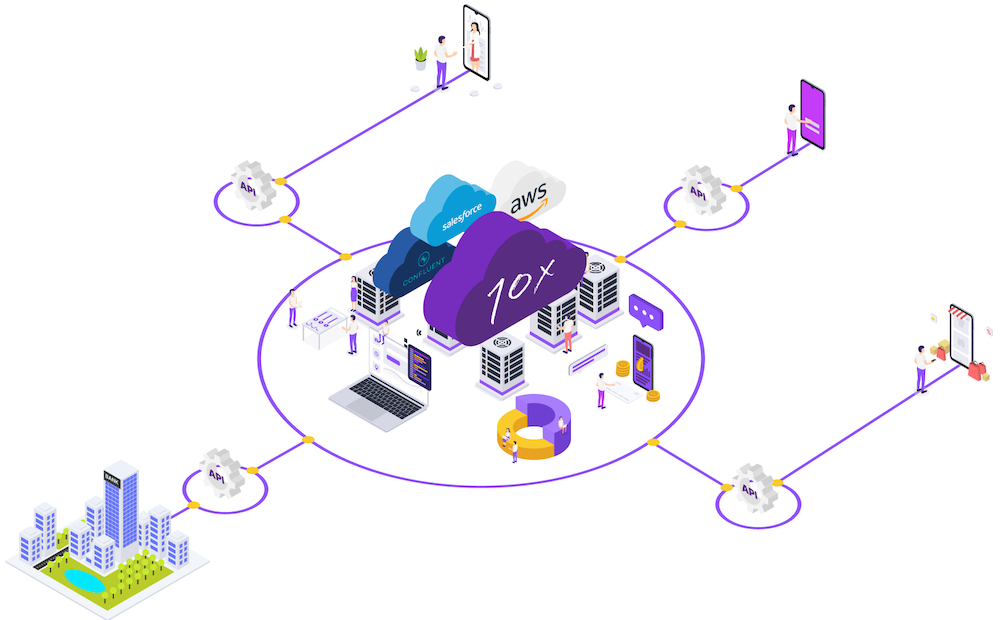With so many people talking about Banking-as-a-Service (BaaS), Joanna England from FinTech Magazine recently asked me 10 questions to clarify what it actually means, what opportunities it creates for banks and customers, and how we can increase adoption.
- What is BaaS, in your words?
So many people talk about Banking as a Service as all the things a bank needs to run in one box. That’s not it.
BaaS is a set of services that require a banking licence to underpin them. It’s how banks can sell their financial capabilities to non-bank entities, such as retailers or merchants. Or other financial services, like challenger banks, who want to expand their product shelf without a giant regulatory admin headache. This could include anything from payments processing and credit to insurance and pensions. It’s regulated finance, which can be provided through a non-regulated entity. The clue is in the name, banks provide their licence as a service - so that brands can better serve their customers.
There are three ingredients to BaaS. You need a banking licence that you’re happy to leverage. You need technology that facilitates the whole thing (that’s where 10x Banking come in). And you need individual services to sit on top, providing customers with a lot more choice.
- How is it changing financial services?
Entirely new economic models are being created. Banks used to be very much B2C or B2B. But increasingly, they are becoming B2B2C or even B2B2B2C.
We’ve seen how traditional banking has suffered over the past years – often dragged down by legacy technology which slows employees and frustrates customers. Nowadays, customers are becoming increasingly accustomed to more direct interactions. No middle men. No unnecessary steps - and they want seamless finance options. And that may well mean transacting with the merchants directly, for the financing of the purchase as well as the purchase itself.
BaaS offers a way to do exactly that, alongside traditional finance.
BaaS is a sustainable and future-proof way of drawing in clients and retaining them with a vast marketplace of financial services and ideas. And like all the best marketplaces, the ones which you never want to leave will be the winners. If you are the platform provider, you want yours to be the most appealing and hence the most competitive.
To achieve this, banks may bring in merchants and products that compete against each other, even compete against the bank’s own traditional offering which is totally different from the old way of doing things. But in this new model it’s necessary to keep banking platforms competitive and consumer options plentiful.
The core principle behind BaaS as a concept – and regulatory imperative – is giving the consumer much more choice at a lower price.
- What does it mean for banks, brands, and end-customers?
For customers, it’s an exciting time. It means you or I could have a financial product that’s not necessarily provided by a traditional bank but linked to it. All the benefits of fully regulated and overseen products, with less of the hassle. More of the choice. And potentially a lower price point. It’s a real win-win-win.
For brands and merchants, of course, it’s an exciting time too. As if by magic, they can offer customers credit from a regulated bank. It reduces risk and boosts sales in one move. And for the banks, it’s a new way of doing business and becoming profitable in a new vertical. Something they’ve needed for a while! To become part of the eco-system and stay relevant, heavy financial institutions need to enter the embedded finance arena: as either platform providers (of which we need few) or as service providers (and here there is space for many, but competition is rife!)
- and 5. Who’s leading the way? Are certain banks, geographies, or markets more prepared to take advantage of this trend?
Well firstly, those savvy companies who happen to have a banking licence in their portfolio - and you’d be surprised how many of those exist! They’re getting a lot out of BaaS and embedded finance.
And secondly, I’d say the traditional banks who see the opportunity of pursuing a parallel business model and have the leadership and vision to go after it! Those banks may have not achieved huge growth as banks and now they see the benefits of BaaS and it’s given them a new lease of life. A digital makeover.
In terms of geographies, it’s developing every day. But if you want to find the next big hotspot, look at the financial regulator. That’s who this BaaS party is hosted by. Even if the regulator doesn’t attend the ball, they facilitated it. They permitted it. They created the parameters of what was needed for it to work, what was expected and what good looked like.
So, we see the most progress in jurisdictions where the regulator has permitted the connectivity of open banking and connected economies and allowed for those business models with an eye on the consumer’s welfare. This gives banks, tech platforms and merchants the impetus they need to dive in.
- What does embedded finance mean for banks?
Embedded finance – integrating financial services within other environments and ecosystems – is game changing for banks. Of course, it means that they can sell their banking services in entirely new ways to new players with BaaS, creating more revenue streams. But it also means they can transform their own end-to-end experiences too. Every process down the line can become better, cheaper, and more efficient.
Capturing data and using machine learning opens a universe of opportunities. Banks can make hyper-personalised product suggestions to customers in real-time. Insurance companies, for example, can make much more detailed credit assessments, slashing their risk. The economies of scale are so great, they can be difficult to fathom.
- Should banks be cautious or excited about BaaS?
Both.
Excited because there is a whole world of opportunity and potential at their fingertips. Not just in terms of new revenue streams. But with game-changing technologies. And bravery will be rewarded in this space. There will be a huge first mover advantage.
And on the flip side of this first mover advantage, slower banks should be cautious because there is only a limited amount of space at the table. Not every bank will be able to build and scale a successful BaaS product, because the world just doesn’t need that many. I don’t think we will ever get to a single-platform economy, but I don’t think we’ll see a huge proliferation of platforms either.
Another important factor for banks to consider is that the economics of this are very different to how traditional banking products make money. The way volumes, charges and revenue shares work are just very, very different. And the biggest mistake any bank could make is try and translate traditional economics onto this, so some caution is needed there too!
- How should they go about entering the space?
They should give 10x Banking a call! ;) The tech piece is the part that the banks should partner on, freeing up headspace to deliver their new business model.
The hard part is working out what your marketplace needs to look like.
If you are a bank you need to recognise that you’ll be dealing with new economics and it’s not banking as usual. You need a very clear sense of mission and purpose as to how you’re going to bring that alternative business model to life. And that’s where the value is.
- Why should banks look to bring BaaS into their business?
There’s undeniably an early-mover advantage for banks to branch out (no pun intended) and offer more services to clients. If they get it right, there’s everything to gain. Imagine if one bank hosted a platform with tens of thousands of plug-and-play financial options. Everything from the customer’s morning coffee to mortgaging the home they sleep in could be seamlessly underpinned by one bank. Thousands of service providers. But one bank. A marketplace that you would never want to leave because you have all the choice you need and all the ease you wish for, in one place. That’s the dream with BaaS. So, banks who strike early on this new economic model could see an incredible boost in profitability and relevance, if they position and scale this right.
But BaaS also comes with a warning to the slow movers. Because of the one-stop-shop nature of these platforms, not that many will be needed. There are limited seats at the table. So, it pays to be bold, do your homework and have a vision about the future. It’s the moment to be proactive, not reactive.
- What’s next?
The next step is adoption. And that adoption will be one where consumers become more and more familiar and comfortable with the marketplaces and working out how to navigate them.
And then the second piece will be embedded finance conversations becoming much more real. What we expect to see now is much more intuitive interdependence between services - where your behaviour over here could trigger your insurance product over there, which could offset your mortgage over here - in ways that feel seamless. In ways that put power back in the hands of the consumer. But for that to happen, we need the consumer to be comfortable with marketplaces. And to understand those inter-connections and consent to them in an informed manner.
We need those marketplaces to become vibrant. We need participants to keep understanding the economics of how collaboration works, and we need the players to become more and more comfortable with interdependence. We're an industry where everyone had a bit of a fortress-mentality for a long time. And everything we've talked about today is about interdependence.
Embracing interdependence is not an easy decision.
And regulatory fail-safes need to be worked through because we're talking about people's savings and people's livelihoods. We don't get to get this wrong, move fast and break things does not work in this industry. Move fast, break nothing. So, we need that adoption and oversight. We need that creativity. We need those economics to work, but I do think that as banking as a service becomes accepted, understood, and fairly established business model for bank, we will see that creativity explode and embedded finance, really becoming a thing.



